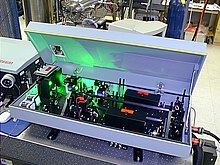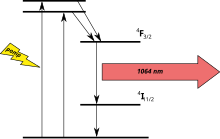Nd: YAG laser
An Nd: YAG laser (short for neodymium- doped yttrium - aluminum - garnet laser; read: neodymium-YAG laser) is a solid-state laser that uses a neodymium- doped YAG crystal as the active medium and mostly infrared radiation with the Emitted wavelength 1064 nm. Further transitions exist at 946 nm, 1320 nm and 1444 nm.
It was developed in 1964 at Bell Laboratories by LeGrand Van Uitert and Joseph E. Geusic (patent 1966).
Advantages and disadvantages
One advantage over the CO 2 laser , which is also frequently used , is that the laser beam can be guided through a fiber optic cable due to its shorter wavelength .
The radiation from these lasers or their scattered radiation is dangerous for the eyes and skin when the power is from laser class 3R. In the eye, it does less damage to the lens and more to the retina . The damage is not noticed by the injured party or only noticed later (skin), since the radiation penetrates far into human tissue and does not cause any thermal or optical irritation reactions.
With this laser it is possible to achieve high powers (up to 10 kW in serial lasers). Both continuous (CW, for English continuous wave ) and pulsed operation are possible. Pulse operation is achieved either by pulsed pumping (flash lamps), Q-switching or mode coupling . With Q-switching, peak outputs of a few hundred megawatts are achieved. The neodymium ions are excited either with gas discharge lamps (flash or arc lamps with xenon or krypton filling) or with laser diodes at a wavelength of 808 nm. The mean life of the excited electrons of the neodymium ions is around 230 µs. Because of this relatively long time, it is possible to store energy in the crystal, which can then be called up in a short pulse (10 to 100 ns) (Q-switching).
In lamp-pumped systems, the efficiency is around 3 to 5 percent, as only a small part of the radiation spectrum lies within the pump level. For example, a laser with 3 kW optical power requires approx. 60 kW input power, of which 57 kW must be dissipated as heat. By stimulating with diode lasers (wavelength 808 nm) the pump efficiency and beam quality can be increased significantly and the overall efficiency increases to approx. 25 to 50%, whereby in this case the physically possible optical efficiency is a maximum of 76%. This is the maximum possible efficiency z. B. under that of Yb: YAG lasers with a maximum efficiency of about 89%.
Applications
Drilling, welding, cutting
Originally, Nd: YAG lasers were only used for micro-bores, for precision cutting of thin sheet metal and for welding individual point connections. In the meantime, due to the increased efficiency and beam quality at high powers, cutting thicker sheets and welding have established themselves as competitors to the carbon dioxide laser that is still frequently used. The fact that the beam can be coupled into a glass fiber and thus easy to equip welding robots is important here. These then have 1D, 2D or 3D optics.
Material testing
Another application of the Nd: YAG laser is the non-destructive acoustic testing of materials with ultrasound on hot or moving parts. Ultrasound is generated here with the help of the photoacoustic effect . The shock-like heating by a laser light pulse leads to thermoelastic effects that excite a wide range of ultrasonic waves.
The Nd: YAG laser is gaining increasing importance in Raman spectroscopy .
Mark / mark
In Q-switched operation, the Nd: YAG laser is suitable for marking a large number of materials due to its high peak power. Often it is done with a mirror scanner. The permanent laser engraving of tools, components and devices has gained in importance in the course of quality assurance and product traceability. Plastics can contain special pigments that cause a clearly visible color change during laser marking (e.g. computer keyboards ).
Inside glass engraving is a special marking application . With a diode-pumped Nd: YAG laser, both in the wavelengths 1064 nm and - through frequency doubling - 532 nm, two-dimensional and three-dimensional structures inside transparent materials can be created in pulsed operation with an average output power of approx. 1… 2 watts (e.g. glass ). Since glass is transparent for the laser wavelength, only Q-switched lasers can be used - the pulse power is so high that the damage threshold of the glass at the focus point can be exceeded.
In addition, the Nd: YAG laser is also becoming increasingly important in electrical engineering. In the still relatively new MID process, in which an injection-molded, three-dimensional plastic part is also an electronic circuit carrier - printed circuit boards are superfluous with this technology - the laser is used to activate the conductor tracks as well as for ablative copper structuring.
medicine
Nd: YAG lasers are also used in medicine for the treatment of hemangiomas (blood sponges), as their wavelength is well absorbed by the red hemangioma tissue and only poorly by water, which is an essential part of the surrounding tissue.
In ophthalmology , it is used to perforate the iris ( iridotomy ) in the context of glaucoma or to remove a secondary cataract ( YAG laser capsulotomy ). By doubling the frequency , it can replace an argon laser and can be used to treat retinal diseases or to improve water drainage in glaucoma (laser trabeculoplasty).
The Nd: YAG laser is used in metastasis surgery, e.g. B. in the resection of lung metastases used. However, Er: YAG lasers are more widely used in medicine and dentistry - these work at a wavelength of 2.8 µm, which is strongly absorbed by water-containing tissue, and can be used in Q-switched mode to remove tissue without causing thermal damage to adjacent tissue.
The Nd: YAG laser is also used to break up kidney stones . The holmium laser (see below ) has been established for this medical laser application since the mid-1990s .
Other uses
The Nd: YAG laser is also frequently used in research. It can easily be doubled in frequency (the clearly visible wavelength of 532 nm is created) and can sometimes be used as a replacement for the argon-ion laser in laser projectors and for show purposes . Green laser pointers are also often frequency-doubled Nd: YAG lasers. The frequency doubling (532 nm) or tripling (355 nm) by non-linear crystals connected to the laser resonator is an efficient method of generating laser radiation of shorter wavelengths, which results in a wide range of applications in which the original wavelength of 1064 nm is not absorbed is.
In optical flow measurement technology, due to their high power yield and the very good beam quality, flash lamp or diode-pumped, pulsed, frequency-doubled Nd: YAG lasers have become established in so-called Particle Image Velocimetry .
In addition, Nd: YAG lasers are used to remove tattoos .
Become military u. a. Nd: YAG laser - so-called "Dazzler" - used as a blinding weapon. The Leopard 2 - battle tanks and the Flakpanzer Gepard uses the Nd: YAG for electro-optical distance measurement .
functionality
By supplying energy / light, the electrons within an atom are excited to different energy levels. The transition to a lower energy level is characterized by the emission of light (e.g. infrared light with a wavelength of 1064 nm). If light is sent to the Nd: YAG crystal, it is called pumping. The neodymium atoms are excited. The light used comes from a gas discharge tube or a diode laser .
Other dopants
Yttrium aluminum garnet can also be doped with numerous other ions for laser purposes, e.g. For example, ytterbium is used in the Yb: YAG laser, the advantage being the higher maximum doping and thus a higher energy density and smaller pane thickness. The wavelength at which Yb: YAG lasers emit is 1030 nm.
The holmium laser is also widespread and must be fully described as the chromium-thulium-holmium-YAG laser. The laser ion is the trivalent holmium ion, while chromium and thulium are used for the absorption and transfer of the flash lamp excitation to the holmium ions. The emission wavelength of the holmium laser is 2123 nm.
The Nd: Cr: YAG laser or Nd / Cr: YAG laser is additionally doped with chromium in order to be able to absorb the radiation for its excitation in a broader wavelength range. This makes it well suited for solar-pumped lasers. Only optical concentrators (e.g. concave mirrors) are used, and you can do without the detour via photovoltaics .
Web links
Individual evidence
- ^ T. Graf: Laser. Basics of laser beam sources 1st edition. Vieweg + Teubner, 2009, pp. 189ff.
- ↑ How does a Nd: YAG laser work? ( Memento from January 5, 2015 in the web archive archive.today )
- ↑ Guideline Nd: YAG laser capsulotomy of the star of the professional association of ophthalmologists in Germany (BVA) ( Memento from September 6, 2011 in the Internet Archive )
- ↑ This is how a Nd: YAG laser works ( Memento from February 1, 2016 in the Internet Archive )
- ↑ Yasser Abdel-Hadi: Solar solid-state laser: laser radiation from solar energy . In: TU International . No. 57 , December 2005, p. 38–39 ( PDF; 353 kB ( Memento from December 15, 2015 in the Internet Archive )).



